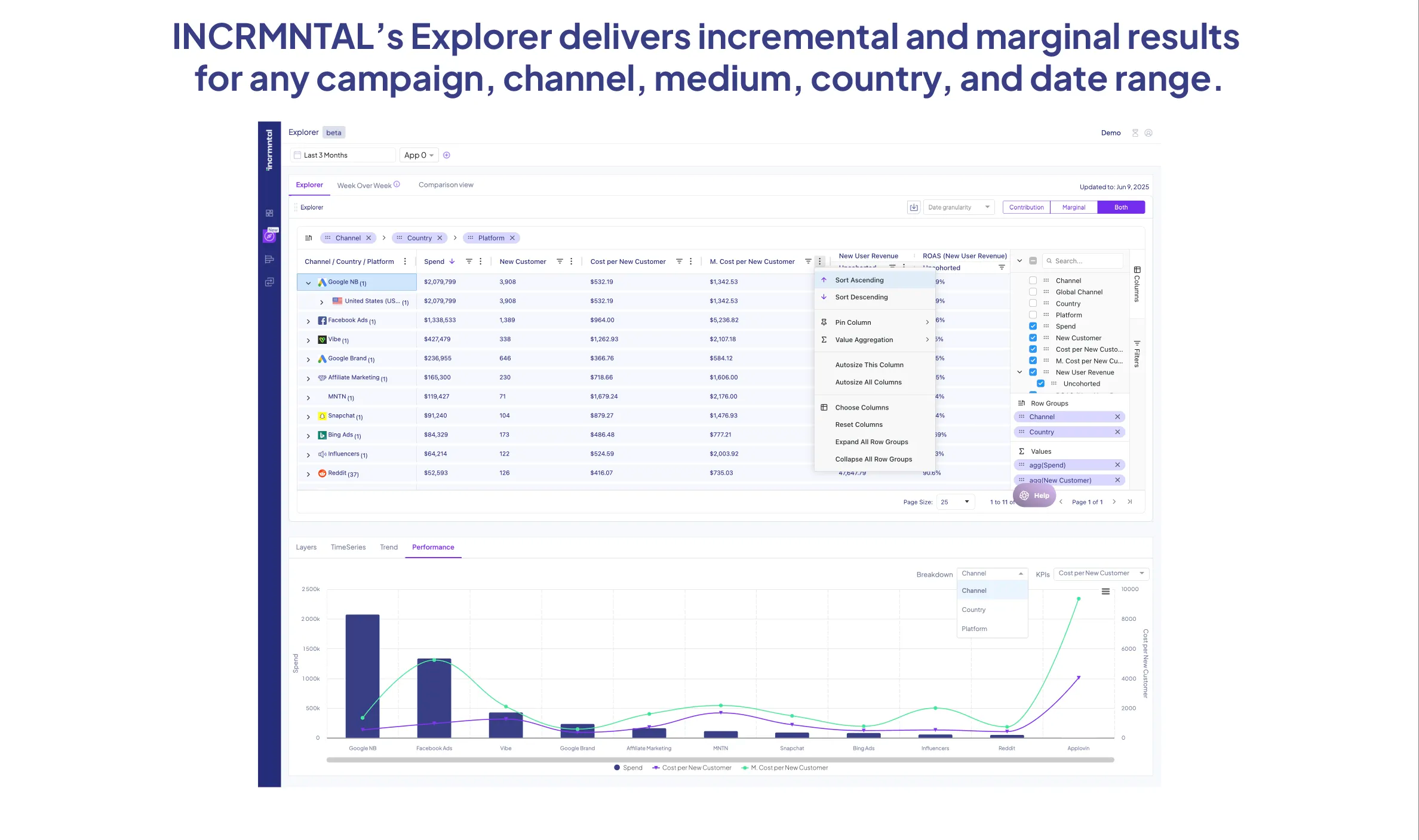Solutions
Teams
Built for your whole team.
Industries
Trusted by all verticals.
Mediums
Measure any type of ad spend
Platform
Use Cases
Many Possibilities. One Platform.
AI and Automation
The Always-on Incrementality Platform
Teams
Built for your whole team.
Industries
Trusted by all verticals.
Mediums
Measure any type of ad spend
Use Cases
Many Possibilities. One Platform.
AI and Automation
The Always-on Incrementality Platform

I recently recorded a podcast episode with my friend and INCRMNTAL investor, Eric Seufert, as part of the MobileDevMemo series. We dove into the hot topics of measurement, privacy, and the AI-driven “Aivolution” reshaping advertising. You can listen to the episode here.
One point that sparked some real interest was my take on data quality - why it’s becoming absolutely critical in this new advertising landscape.
In this article, I unpack why advertisers managed to survive with sketchy data quality for so long, but more importantly, why they can’t afford to compromise on it moving forward. Plus, I’ll explore the emerging need for a Marketing Data Engineer and what that role might look like in practice.
Let’s start by breaking down the core data quality challenges - so you can figure out if it’s time to bring that specialist onto your team… or hold off just a bit longer.
For years, marketing organizations lived in silos. Brand marketing and performance marketing were treated like distant cousins at family reunions: related but rarely talking. Separate teams, separate tools, separate budgets. Only the CMO and CFO got a blurry panoramic view of the whole picture. Coordination between the teams? At best, cursory. At worst, ignored.
Brand marketing was hard to measure – since most of it was impossible to track. Brands leaned on fuzzy metrics like awareness or recall, which were nice vanity numbers but lacked a direct link to revenue. As a result, brand marketers got a pass on demanding sharp data quality because their impact was measured with a blurry lens.

Performance marketing was the opposite. Here, digital advertising meant tracking clicks, impressions, and conversions - often in near real time - using “deterministic” attribution tools that connected ads directly to sales. This was the playground of “hard data.” But here’s the kicker: those attribution tools are now relics, being swept away by privacy laws and AI-driven attribution that rely less on tracking individuals and more on probabilistic models.
Media buying was simpler when digital was the focus and legacy attribution tools “did the job.” Advertisers didn’t fret much about multi-device complexity or cross-platform chaos. The luxury was in having a clean, single source of truth - mostly digital - and the world wasn’t quite as fragmented.
Agencies complicated things further by often providing aggregated, “digested” reports instead of raw data. This aggregation masks problems, leaving marketers to optimize blindfolded across increasingly diverse media channels.
Different media types - TV, CTV, influencer marketing, podcasts, affiliates - all have unique measurement quirks. Settling for data without detailed breakdowns, without context, or without daily granularity is like flying blind in a storm.
Back when a macro-level report showing “We spent $X and made $Y” was acceptable, CMOs and CFOs were happy. They made strategic decisions from these big-picture views. But tactical teams were often forced to use low-quality data, which introduced risk and inefficiency. Today’s privacy-first and AI-first realities mean we can no longer afford this compromise.
Privacy was the spark that set the data quality fire burning, but AI is the inferno reshaping marketing measurement. Platforms no longer rely on simple attribution postbacks, and modern CMOs finally realize brand marketing is measurable - just not traditionally trackable.
We’ve seen data that was only on channel level. No campaign level data. Just “Google”, global, spend. If you think that this is just a one off – Prepare to learn what other versions of data quality we’ve seen.
We’ve seen client’s data that blends ad spend across multiple countries without any ability to break the data by country. i.e. US, Germany, Japan – combined. Take a second to think why this would make any attempt to utilize the data properly not possible.
We’ve seen clients with 50% of their conversions attributed to “unknown” country.
Others get TV ad spend front-loaded artificially to the first of the month because that’s how the agency reports it.
And influencer marketing activities? Sometimes they’re a black box.
These cracks in data quality aren’t just inconvenient - they’re strategic liabilities.

Data quality doesn’t mean just one thing. It’s about getting all the parts needed to build the puzzle; we split data into two realms: KPI/Metrics data and Advertising data.
If you just leave it to your MMP or Google analytics to choose – this may completely not align with your own definition of either of these. To demonstrate this easily - A user installing your app to order a pizza, uninstalling it once delivered, installing a day later to get a burger, uninstalling within a week, reinstalling a few days later to get Chinese food – is this one new user ? or three new users ? If you don’t control your definition – whatever the default setting is on your attribution platform is – that would be the definition.
Are your users from the country where they converted? Or from the country they selected in an onboarding process? And what if their payment info is in a different country?
Best practice would suggest using the country where they converted, if you are just measuring advertising effectiveness, but this would conflict with how you analyze financial data, or create various LTV predictions.
If your product is available as an App or a Website – who is an “App” user and who is a “web”? what if a user started their funnel on web, but completed their first transaction on mobile?
Having a clear definition of your cross platform logic is not only valuable, but is critical so that you don’t double, triple, or 100x count conversions.
Are you measuring your success based on all sales happening within a period? Or are you looking at sales cohorted to conversions happening within a certain period?
If you’re trying to acquire new customers as a primary objective – cohoretd would be the way to go, but may cause you to lose sight over total market saturation.
Are you optimizing your campaigns, brand & performance, towards a CPA goal? ROAS or ROI goal? a cohorted ROI goal? or are you actually only measuring incremental revenues ?
Having a singular goal would make any marketing team more efficient, but may also miss the broad picture.
I could easily elaborate a full blown article about each of the above bullet points. Maybe at some point – I will. But this would only be half the picture…as we still need to deal with Advertising data issues.
If you’re running a search campaign, your traffic may come from web, or mobile. Should you define the buying platform as mobile by the campaign objective (destination URL being an app), or should you rely on the ad delivery platform (i.e. Web / Mobile).
Influencer marketing is really popular these days, but how you split this “spend” has to do with language, postdate, and reach. If you ran a $1M Mr. Beast campaign – do you split the $1M amongst all 200+ countries based on the video view count? Do you consider language? Do you allocate the $1M to the date of the post? Or do you split it over a period of time, and how ? The way you allocate your spend reporting will directly influence the measurement of.
TV ad spend is typically measured by GRPs (gross rating points), while CTV is measured by impressions. But often we would see TV data only as “budget allocated”. Advertisers should consider any bonus delivery, daily reach/views, and try to normalize TV data as close as possible to digital video – because guess what – in 2025 – that’s exactly what it is!
Affiliate marketing is a unique medium, where you as the advertiser pays for an action, rather than an early conversion. To measure this correctly – one needs to align back the payout data (i.e. “spend”) to the conversion date! And tip – the best affiliate platforms do already support this in their own reporting.
Advertisers may also be active on various brand partnerships, sponsorships, or advertising across esoteric channels or mediums. To include those in the marketing map – Advertisers need to consider each of these and gain as much normalized data for these activities to be even considered: Reach, expected reach, distribution, impressions, or any data point available.
If you thought this list was long – you’re almost correct, as on top of this, external/internal features like app updates, app featuring, competitor moves, and shifting variables complicate the picture further.
When results were “good enough,” no one asked questions about data quality. But AI changed the game. It’s brilliant at solving complex puzzles, but only if the pieces you feed it are clean and structured. Garbage data fed to AI results in garbage decisions, and nobody wants a multimillion-dollar campaign blown on bad info.
We’re shifting from a deterministic acquisition funnel to a probabilistic one. The biggest advertising platforms are already there, and have been for a while. When you start a UAC, or a PMAX campaign – Google is no longer asking you to define your bids, or target keywords. These campaigns are generating ads, figuring out themes, targeting, and self-optimize based on a probabilistic signal that they create based on very little feedback you provide them.
Meta took is further – with a continuous holdout, targeting incrementality from their own perspective. We’re probably less than months away from Meta only asking you for your objective, and a credit card details, while everything else would be generated by the platform.
All major ad platform we are connected with is either already doing this, or planning to do this. Applovin, TikTok, Moloco, Liftoff, Smadex, ROKU, Twitter/X, Snap, REDDIT, and the list goes on…
AI is replacing every point in the value chain. From the Advertising platform, to measurement.
The role of measurement becomes active, rather than a passive player. Measurement is just a means to an end, as I recently wrote in the article “I Measured Incrementlaity. Now What?”.
Our role in the world is not to “measure incrementality” – either as a one off, or even continuously. Our role is to use AI to measure true impact, and push a signal to another AI to use as it’s reward or punishment to react.
Signal engineering - crafting the right, clean signals - is now paramount because AI models consume your data and output decisions that drive billions in spend.
In fact, companies like us at INCRMNTAL are racing to grab this space, each from their own perspective, making data quality not just important but a critical competitive advantage.

If you want to get serious, start with:
I believe that most scaled advertisers will start feeling the same “pain”, and will seek to resolve this. The solution is not a BI person detached from the marketing organization, but a person that is an integral part of the Advertising/Marketing department, and is as responsible for ensuring that the data pipeline makes sense to feed AI ad platforms, and AI measurement platforms – ensuring a high scrutiny of data quality.
How we would see the Role Description ?
A Marketing Data Engineer is the guardian of data quality and structure, bridging marketing, data science, and engineering to deliver clean, actionable data that powers AI-driven marketing decisions.
Key Requirements:
You may use this template to find such a person for your own organization.
Ask yourself:
If you hesitated or said yes to any of these, it’s time to bring a Marketing Data Engineer onboard.
If you want to nerd out about this topic or explore building this role in your team, reach out via LinkedIn or our contact page. This is where marketing’s future is being shaped, and data quality is the foundation.

Maor is the CEO & Co-Founder at INCRMNTAL. With over 20 years of experience in the adtech and marketing technology space, Maor is well known as a thought leader in the areas of marketing measurement. Previously acting as Managing Director International at inneractive (acquired by Fyber), and as CEO at Applift (acquired by MGI/Verve Group)